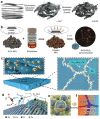Advances and Challenges in SnTe-Based Thermoelectrics
- PMID: 39887470
- PMCID: PMC11899516
- DOI: 10.1002/adma.202418280
Advances and Challenges in SnTe-Based Thermoelectrics
Abstract
SnTe-based thermoelectric materials have attracted significant attention for their exceptional performance in mid-to-high temperature ranges, positioning them as promising candidates for thermoelectric power generation. However, their efficiency is constrained by challenges related to electronic structure, defect chemistry, and phonon behavior. This review comprehensively summarizes advancements in SnTe thermoelectric materials and devices over the past five years, focusing on strategies to address these limitations. Key approaches include defect regulation, carrier transport optimization, and phonon engineering to enhance electrical conductivity, reduce thermal conductivity, and improve overall thermoelectric conversion efficiency. The review highlights breakthroughs in fabrication methods, doping and alloying, composite designs, and the development of novel nanostructures, with particular emphasis on 2D SnTe materials such as monolayers, bilayers, and thin films, which offer new opportunities for performance enhancement. Additionally, it provides an overview of SnTe-based thermoelectric devices, covering fabrication techniques, performance optimization, stability, and flexible device development. Despite significant progress, challenges remain in developing n-type SnTe materials, optimizing interfaces, ensuring long-term stability, and maximizing conversion efficiency. This review fills gaps in the existing literature and offers valuable insights and guidance for future research aimed at improving thermoelectric properties, advancing device integration, and driving the commercial viability of SnTe-based materials for practical applications.
Keywords: SnTe; device; material; structure; thermoelectric.
© 2025 The Author(s). Advanced Materials published by Wiley‐VCH GmbH.
Conflict of interest statement
The authors declare no conflict of interest.
Figures
























References
-
- Geffroy C., Lilley D., Parez P. S., Prasher R., Joule 2021, 5, 3080.
-
- Qin B., Wang D., Liu X., Qin Y., Dong J.‐F., Luo J., Li J.‐W., Liu W., Tan G., Tang X., Li J.‐F., He J., Zhao L.‐D., Science 2021, 373, 556. - PubMed
-
- Bell L. E., Science 2008, 321, 1457. - PubMed
-
- Qin B., Kanatzidis M. G., Zhao L.‐D., Science 2024, 386, adp2444. - PubMed
-
- Shi X.‐L., Zou J., Chen Z.‐G., Chem. Rev. 2020, 120, 7399. - PubMed
Publication types
Grants and funding
LinkOut - more resources
Full Text Sources
Miscellaneous

